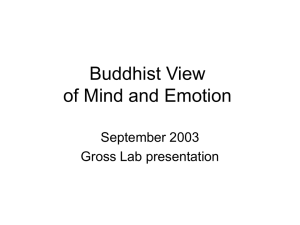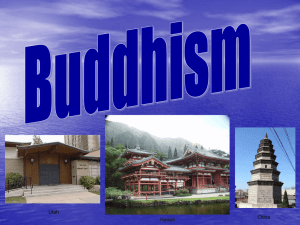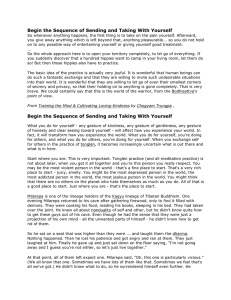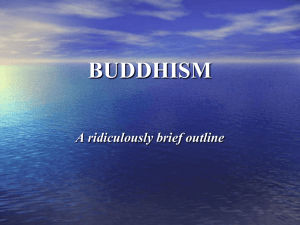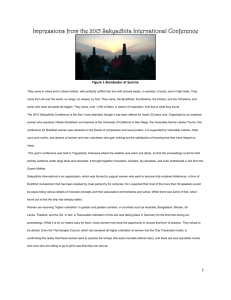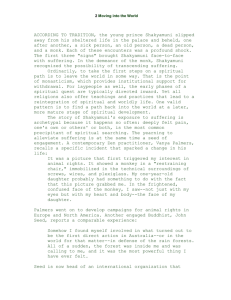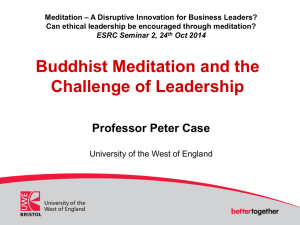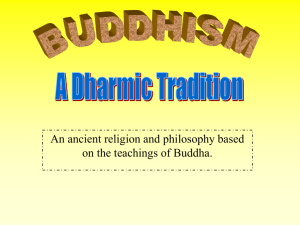Buddhist Methodology and View of Mind
advertisement
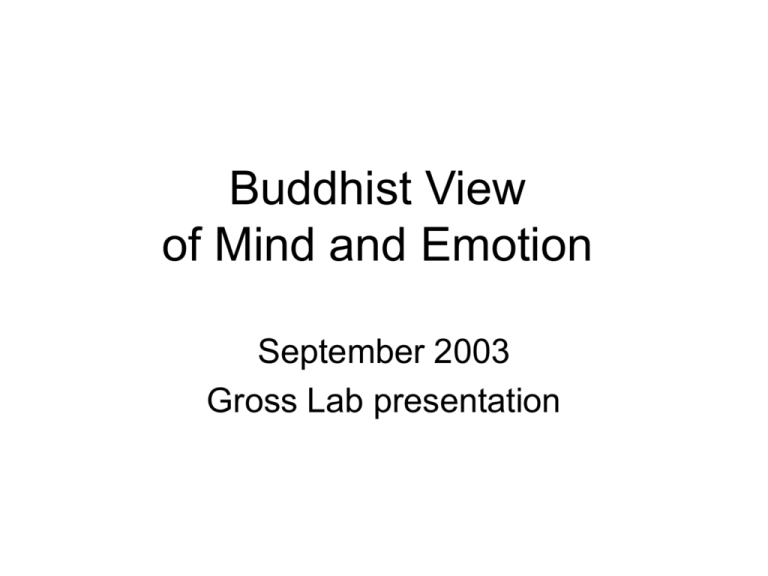
Buddhist View of Mind and Emotion September 2003 Gross Lab presentation Scientific Method • “Principles and procedures for the systematic pursuit of knowledge involving the recognition and formulation of a problem, the collection of data through observation and experiment, and the formulation and testing of hypotheses.” Webster’s Ninth New Collegiate Dictionary • Does Buddhism include this procedure in its inquiry into the nature of the mind and consciousness? • Fundamental spirit of empiricism and skepticism Framework of Buddhist theory and practice: Four Noble Truths The truths of suffering • recognize the nature and full range of suffering to which humans are vulnerable The source of suffering • hypothesis that the essential causes of suffering are to be found within the mind, specifically in terms of cognitive, emotional, and attentional imbalances The cessation of suffering together with its source • afflictive tendencies can be irreversibly dispelled from the mind The path leading to that cessation • detailed procedures for collecting data by observing mental processes and experimenting with techniques for transforming the mind and eliminating its afflictive elements The Buddhist Endeavor • Primary emphases – Normal mind is habitually conditioned to states of attentional, emotional, and cognitive imbalances, but is not intrinsically dysfunctional – Experiential investigation of the mind to identify – Removal of cause of confusion: invalid cognitions about self-existence – Facilitate development of long-term beneficial qualities (i.e., patience, compassion, clarity, insight, spontaneity) • Fundamentally pragmatic orientation: – Ethical conduct • self-regulation of behavior, thought, and emotion – Mental concentration • attention training to dispel imbalances of laxity and excitation, and to attain stable, lucid, and calm mind – Wisdom understanding nature of existence • free the mind of afflictions, obscurations, misconceptions Is it possible to observe mental states and processes with the mind? Even with no mental training, we can detect: • Emotional states • Observe thoughts and images arising in the mind • Introspectively recognize from moment to moment whether our minds are calm or agitated • Perceive that we are consciously aware of: – objects of consciousness – the presence of our own consciousness of other things Madhyamaka “Middle Way” View • Pinnacle of Buddhist philosophy • Both physical and mental phenomena have no independent or permanent ontological status • Mere localized appearances emerging from a network of non-local correlations • Things exist as dependently related events, not as autonomous, inherently existent, localized entities Consciousness • Mind: cognizes the mere entity of an object – 6 types: visual, auditory, olfactory, gustatory, sensory, mental awareness • Mental factors: cognizes features of an object – 5 omnipresent, 5 determining, 11 virtuous, – 6 root afflictions, 20 secondary afflictions, – 4 changeable 5 Omnipresent • Feeling (pleasure, pain, neutrality – the fruitions of previous virtuous and nonvirtuous actions) • Discernment • Intention • Contact • Mental engagement Future Prediction “it is probably safe to say that by 2050 sufficient knowledge of biological phenomena will have wiped out the traditional dualistic separations of body/brain, body/mind and brain/mind.” Antonio R. Damasio, (2002) “How the brain creates the mind.” in Scientific American, 12: 4-9 Meditation and Immune Research Findings • randomized, controlled study 8-week mindfulness meditation stress reduction program applied in a work environment with healthy employees • significant increases in left-sided anterior EEG activation, a pattern previously associated with positive affect, in the meditators compared with the nonmeditators 4 months post-program • significant increases in antibody titers to influenza vaccine among subjects in the meditation compared with those in the wait-list control group • magnitude of increase in left-sided activation predicted the magnitude of antibody titer rise to the vaccine Davidson et al. Psychosom Med. 2003 Jul-Aug;65(4):564-70
